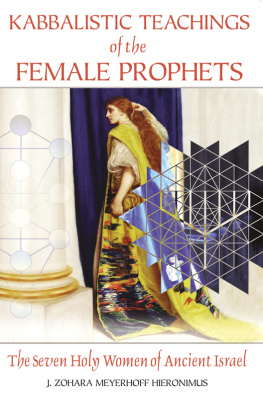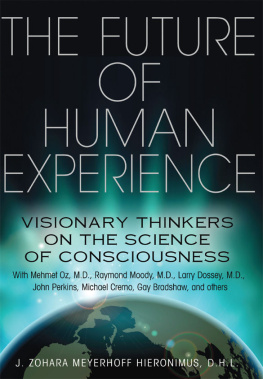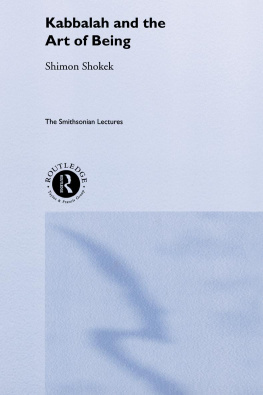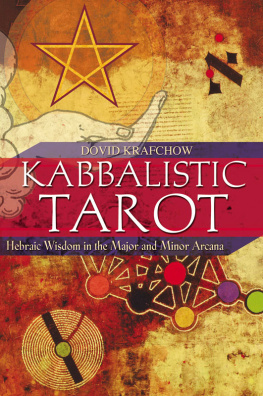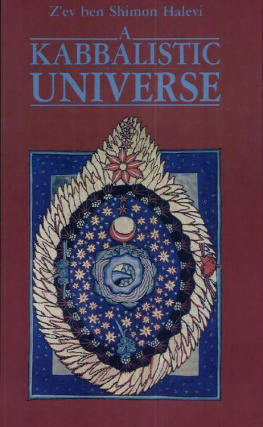KABBALISTIC
TEACHINGS
of the
FEMALE
PROPHETS
The Seven Holy Women
of Ancient Israel

J. ZOHARA MEYERHOFF HIERONIMUS

Inner Traditions
Rochester, Vermont
Like the scent of goodly oils is the spreading fame
of Your great deeds: Your very name is Flowing
Oil, therefore have nations Loved you.
SONG OF SONGS 1:3
Praise HaShem, Host of Hosts
For giving us life and His Torah.

Acknowledgments
Without the enduring love of my husband, Dr. Robert R. Hieronimus, and his regard for the spiritual path, I would have been less able to pursue the prophetic lineage of which our age is an inheritor. Love to my Meyerhoff and Hieronimus families, the Hendlers, Rubensteins, Pancoes, Katzes, Schewels, and all their branches for their support, wisdom, and humor; and to my ancestors for their own love of Torah, HaShem, and the People of the Book. May their memory be for a blessing! A special acknowledgment to my great-grandfather Oscar (Asher) Meyerhoff (18641946) for informing my heart and soul from above with a love of Chassidut and Torah, and for planting our family tree in America. Thank you to all the women who have taken part in my classes and discussions on the teachings of the seven prophetesses of Israel and for sharing, in joy, these remarkable women. For my daughter, Anna, and stepdaughter, Mare: May the prophetesses guide you in finding peace and purpose in your own lives. Great thanks to Laura Cortner for her constant and tireless assistance in whatever is needed, and to Meghan Bowen and Alden Brigham for taking care of my broadcasting needs. To all the wonderful providers at the Ruscombe Mansion Community Health Center, which I founded in 1984: May your loving attendance of others continue to be blessed.
Gratitude to R. Avraham Brandwein, Samuel Ben-Or Avital, R. Noah Shavrick, and R. Simon Jacobson for their guidance in Torah and Kabbalah.
Shalom Shalom to the blessed Chazal (sages) whose teachings illuminate our minds and hearts, bringing us closer to God, Torah, and peace.
I give great appreciation to R. Schneur Zalman (Baal HaTanya, author of Likkutei Amarim Tanya); R. Yaakov Ibn Chaviv for his sixteenthcentury work, Ein Yaakov, and R. Avraham Finkel for his translation of it; and R. Moshe Chayim Luzzatto (the Ramchal, 17071747 CE) and R. Moshe Cordovero (the Ramak, 15221570 CE) for all of their illuminations. In addition to the Torah, their writings, translated into English, were my primary set of keys, along with Gutman Lockss The Spice of TorahGematria, in my journey with the seven prophetesses of Israel and the teachings of which they are a part.
Blessings to Inner Traditions International, with special gratitude to Jeanie Levitan, Jamaica Burns, and Elaine Cissi, for their editorial excellence and for making it possible to share the female prophets and their holy lives with others. May the reader benefit by the shining light of their guidance.
ROSH CHODESH, 30 NISSAN, 5767
APRIL 18, 2007

Preface
The female prophets are the seven holy women of Israel who lived between the Middle Bronze Age (1880 BCE) and the end of the Persian period (350 CE). A study of their communal lives shows how the holy presence of God reveals itself through prophecy in the world and in our lives and follows a fundamental progression or an archetypal story for all of humanity. Their collective story is one of conception, birth, learning correct moral action, achieving holy spiritual conduct, the existence of royal lineages as a result of both birth and spiritual merit, and the promise of the Moshiach (Messiah) and of the World to Come (Olam HaBa), all culminating in the promise of redemption and resurrection.
The seven prophetesses of Israel are Sarah, Miriam, Devorah, Chanah, Avigail, Chuldah, and Esther. Together, these seven women embody the Creators presence in Judaism, referred to by the People of the Book as the Divine Immanence of the Creator or the Shechinah. Each prophetess has her own story to tell, and though each womans nature and apparent purpose is a model for all of us cultivating our own intuition, self-refinement, and closeness to God, an analysis of the combined lives of all the prophetesses, spanning almost two thousand years, creates a system of evolution and development as pertinent to our lives today as it was for the biblical communities in which they originated. The details of their lives are also important to discover, for in them we find the capacity for prophecy, an ability to speak for and with the Creator, as well as the excellence of loving-kindness, leadership, beauty, fortitude, humility, sacrifice and sovereignty in service to the Creator, the word of God, and the goal of personal and global harmony and redemption.
Others have shown correlations between the lives of these women and different aspects of Kabbalah, but not in the manner in which this book explores them. The Holy Sage the Arizal (R. Isaac Luria, 15341572) teaches of the relationship between the seven species of Israel (wheat, barley, grapes, figs, pomegranates, olive oil, and date honey) and the Sefirot, or spheres of the Tree of Life. The Holy Sage the Ramak (R. Moshe Cordovero) tells us of the relationship of the seven prophetesses to seven of the overall ten Sefirot of the Tree of Life. These correspondences help us see how our lives are part of a greater spiritual model. In addition, I have included other systems of seven, such as the corresponding days of the week. Doing so gives the reader a helpful guide to focus each day on a particular quality inherent in the divine plan of the Creator reflected as it is in our world.
A comprehensive integration of all of these elementsthe prophetesses, the Sefirot, the body, the seven species, the days of the week, and the appropriate texts from the Judaic holy booksshows us a way of living and acting in the world in any given situation in a way most harmonious to the root nature of the Creator in whose image we are made.
These systems of seven manifest as a very specific progressive development for Israel and every human being, symbolically and literally. The story of the seven prophetesses of Israel is the story of every persons journey in general and the spiritual story of the Jewish people in particular. From creation to redemption and ultimately resurrection, it is the story of our entire worlds development. It points not only to where we come from, but also to where we are soon to be in the promised thousand years of peace, the messianic age.
THE PROPHETESSES AND THE
TREE OF LIFE (ETZ CHAYIM)
We will study each of the prophetesses particular role in biblical history and look at how each of them defines a different aspect of life for us individually, for the nation, and for the world. We will see through ancient Kabbalistic teachings that each prophetess is connected to the Sefirot, or vessels, characterized throughout Kabbalah as the Tree of Life (Etz Chayim). They are the Sefirot composing what are called the seven emotions (middot):
Loving-kindness (Chesed)
Judgment (Gevurah)
Beauty (Tiferet)
Victory (Netzach)
Majesty (Hod)
Foundation (Yesod)
Kingdom (Malchut)
The prophetesses unique qualities and the Sefirot they represent are revealed through a study of Torah, the prophetesses Hebrew names, and other sources. Correspondences we will study include how the Sefirot of Kabbalah, in addition to their spiritual functions, have accompanying symbolic body parts in the human being. What we learn about each Sefirah and prophetess from this perspective can help us in our repair of the world (
Next page
